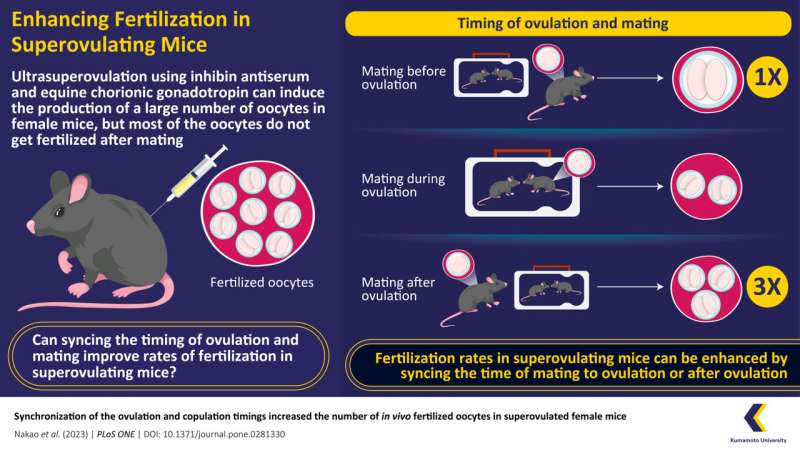This article has been reviewed according to Science X's editorial process and policies. Editors have highlighted the following attributes while ensuring the content's credibility:
fact-checked
peer-reviewed publication
trusted source
proofread
Synchronizing ovulation with mating improves fertilization in 'ultrasuperovulated' mice

Ultrasuperovulation is an advanced technique that significantly increases the number of oocytes produced by female mice. However, existing ultrasuperovulation techniques have a low fertilization rate, probably caused by the low incidence of sperm reaching the female's oocytes in vivo. Now, a group of researchers from Japan found that mating ultrasuperovulated mice with their breeding partner during or after ovulation can overcome this limitation and improve fertilization rates.
Mice are an indispensable part of experiments in several research fields, including biotechnology and medical science. Since maintaining a breeding strain of mice is essential in most cases, increasing the litter size of these animals is eagerly pursued. Female mice produce about eight to ten oocytes during ovulation. Usually, all the oocytes that are ovulated from the ovaries get fertilized during mating, resulting in a similar number of pups. Now, while scientists have invented techniques to vastly increase the number of ovulated oocytes, these "ultrasuperovulation" techniques fail to produce a similarly large number of fertilized oocytes.
In a study recently published in PLOS ONE on Feb. 6, 2023, researchers from Japan have demonstrated that synchronizing ovulation and mating can increase the fertilization rate in ultrasuperovulated mice. In the study led by Satohiro Nakao and Kotono Ito of Kumamoto University, researchers divided mice into three groups based on the timing of their ovulation—pre-ovulation, during ovulation, and post-ovulation.
Mating female mice with their breeding pair during or after ovulation resulted in a significantly greater number of fertilized oocytes than when they were housed together before ovulation. Professor Toru Takeo, the corresponding author of the paper, who is also affiliated to Kumamoto university, noted that "the number of embryos obtained post-ovulation was three times higher than that obtained pre-ovulation."
Superovulation is induced in female mice by injecting equine chorionic gonadotropin and human chorionic gonadotropin (hCG). It results in the production of about 20 oocytes and a similar number of fertilized oocytes. Researchers involved in this study had previously discovered an improved technique for superovulation in mice that uses inhibin antiserum and equine chorionic gonadotropin. While this technique, dubbed "ultrasuperovulation," resulted in over 100 oocytes being released by ovulating mice in each cycle, the number of fertilized oocytes remained around 20.
The team hypothesized that the low fertilization rate was caused by a low number of sperm reaching the oocyte in the ampulla, the region of the fallopian tube where fertilization typically occurs. Although millions of sperm reach the uterus during mating, only a tiny proportion swim far enough to reach the ampulla. This can be remedied by timing the mating of mice. According to Prof. Takeo, "The results of this study suggests that a sufficient number of sperm reaches the ampulla to fertilize the oocyte when ovulation and mating are synchronized."
The time of ovulation induced by superovulation techniques has been accurately established. In the study, the mice in the "pre-ovulation" group were mated 0 to 10 hours, the "during ovulation" group mated 10 to 15 hours, and the "post-ovulation" group mated 15 to 19 hours after receiving an hCG injection.
The underlying physiological mechanism that is responsible for the three-fold increase in fertilization rate demonstrated in the study is not clear. However, Professor Takeo notes, "Synchronizing the ovulation and copulation timings may support the sperm to enter the oviduct and achieve fertilization by riding the oviductal fluid flow; although further studies are required to confirm this phenomenon."
The findings of the study have several potential practical implications. As mentioned before, a method to increase the reproductive capacity of genetically altered mice that are widely used in scientific research can be highly beneficial. Moreover, the results may help in improving infertility treatments in humans.
More information: Satohiro Nakao et al, Synchronization of the ovulation and copulation timings increased the number of in vivo fertilized oocytes in superovulated female mice, PLOS ONE (2023). DOI: 10.1371/journal.pone.0281330
Journal information: PLoS ONE
Provided by Kumamoto University




















